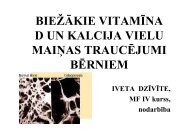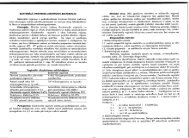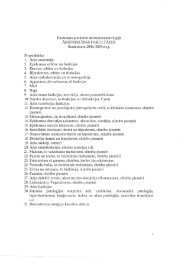PHYSICS
n - susliks.lv
n - susliks.lv
- No tags were found...
You also want an ePaper? Increase the reach of your titles
YUMPU automatically turns print PDFs into web optimized ePapers that Google loves.
force is called gravitropism. The roots which grow toward the<br />
center of the earth, demonstrate positive gravitropism; while<br />
shoots, which grow away from the center of the earth, exhibit<br />
negative gravitropism. When the plant is set on a rapidly rotating<br />
turn-table, the roots grow away from the center just as they normally<br />
grow towards the center of the earth (fig. 5.8). Specific<br />
characteristics of gravitropism are: the force of gravity is constant;<br />
there are no gradients of gravity; and it is not possible to switch<br />
on or off the force of gravity.<br />
<br />
I<br />
wi<br />
I<br />
orr<br />
~<br />
g R<br />
Fig. 5.8. The plant demonstrates<br />
the growth at an angle eto the<br />
vertical if a flower-pot is set on<br />
a rapidly rotating turn-table;<br />
this angle 8 is determined by<br />
the resultant R of the<br />
gravitational g and inertial orr<br />
accelerations<br />
5.2.2. Effect of Mechanical Factors on Plants<br />
Many plants exhibit nastic movements, which occur in response<br />
to external stimuli such as touch, vibration, mechanical<br />
injuries, light, and chemical treatment. The direction of nastic<br />
movements does not depend on the direction of stimulus. It is necessary<br />
to distinguish the very rapid seismonastic movements and<br />
38<br />
Gravitational Orientation in<br />
Microorganisms. Light and gravity<br />
are the most important<br />
external factors for motile microorganisms<br />
which are faced<br />
with a problem of selecting the<br />
best conditions for their survival.<br />
In addition to photomovement,<br />
which depends on parameters<br />
of light, such as direction,<br />
intensity, gradients of intensity<br />
and wavelength, many<br />
cells show gravitaxis - the ability<br />
of microorganisms to orient<br />
their direction of movement<br />
relatively to the gravitational<br />
field of the earth. Algae, such as<br />
Euglena gracilis, Chlamydomonas<br />
nivalis, Cryptomonas, Peridinium<br />
gatunense, P. faeroense, Amphidinium caterea, Prorocentrum micans,<br />
Dunalialla salina, demonstrate gravitaxis, allowing them to<br />
establish vertical distribution patterns. They are capable of active<br />
movement and daily vertical migration of up to 15 m.<br />
the thigmonastic movements. The first type of movement is caused<br />
by touch. For example, when a plant (Mimosa pudica) is touched,<br />
its leaflets rapidly fold downwards in just seconds. This type of<br />
response is used as a way of protection against the wind and<br />
insects and other herbivores. Seismonastic movements are related<br />
to reversible turgor changes in the pulvini - specialized cells at<br />
the base of the leaflets.<br />
Thigmonastic movements are related to a response of some<br />
plants to mechanical stimulation such as shaking, falling raindrops,<br />
mechanical wounding, cutting. For example, Pisum sativum<br />
and Passiflora coerulea, display this type of response to<br />
mechanical stimuli.<br />
5.2.3. Plant Response to Wind<br />
In addition to the stimulation of nastic movements in plants,<br />
the wind is involved in heat and mass transfer, changes the<br />
boundary layer resistance, and the rate of evaporation. Wind can<br />
also induce significant asymmetry in plant architecture by way of<br />
either direct damage (breaking of stems or foliage) or indirect<br />
damage via materials such as salt and sand transported by it. A very<br />
important agricultural problem is lodging of cereals which can<br />
cause a decrease in harvestable yield due to poor light penetration<br />
to the canopy, damaged conducting system, and weakening of<br />
photosynthetic activity of the plant. Also noteworthy is that wind<br />
mediates the deposition and dispersion of soil, plant pollen,<br />
seeds, spores, and droplets of agrochemical substances.<br />
VOCABULARY<br />
English Ukrainian English Ukrainian<br />
Allometry Anouerpis Moment MOMeHT<br />
of inertia inepnii<br />
Angular Kyrose Muscle M'513<br />
displacement 3MIllleHH5I<br />
Average Cepenac Muscle spin M'5130Be<br />
acceleration rrpI1CKOpeHH5I sepereno<br />
Average angular Cepenns xyroaa Myofibril Mio¢i6pina<br />
velocitv<br />
umazrxicrt,<br />
Average velocity Cepezms Neuromast Heapoxracr<br />
lllBI1,nKICTb<br />
39






